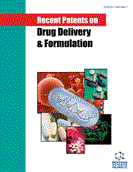Abstract
Various encapsulation approaches have been explored during the last years in order to encapsulate classical active molecules and new synthesized molecules principally for the in vivo therapy as drug delivery nanocarriers and also for the in vivo biomedical diagnostic. These approaches lead to new and versatile systems exhibiting high encapsulation yields of small molecules mainly. Due to the use of biodegradable polymers, the final particles and dispersions exhibit low cytotoxicity and in some cases total biocompatibility. To enhance local targeting efficiency, nanoparticles are chemically grafted using specific antibody for a specific disease. One of the easiest processes leading to rapid particles formation is the nanoprecipitation. Such process is mainly based on polymer transfer from good solvent to poor solvent condition, leading consequently to nanoparticles formation via self-assembly of precipitated polymer chains. The article discussed some of patents associated with Nanoprecipitation Process.
Keywords: Active molecule protection, controlled drug release, nanoprecipitation, preformed polymer, polymer-based nanoparticles, POLYMER PRECIPITATION, NON-LOADED NANOPARTICLE SUSPENSION, COSMETIC USE, cutaneous applications, transdermal transport.
 27
27














